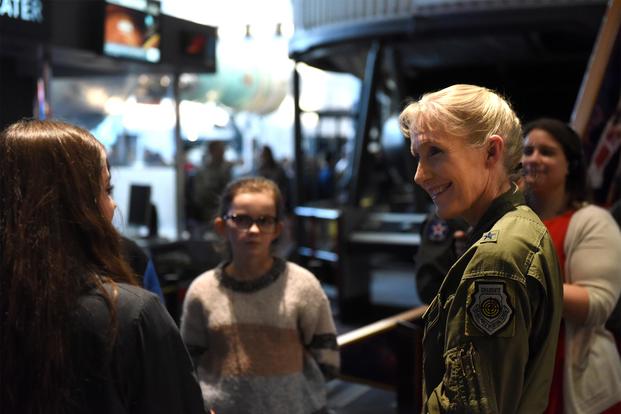AIR AND SPACE MUSEUM, Washington, D.C. -- Standing beside the Air Force's first female fighter pilot Thursday night as troops, fans and families lined up to see Marvel Studio's latest superhero on the silver screen, Air Force Secretary Heather Wilson said she was encouraged to see young kids making their way forward not only to celebrate a movie, but perhaps be part of the service's future story.
"All of us have been inspired by moments in history, or films we've seen in our lives that inspired us to do something, or stand up, and I'm really hoping this touches young people about who they can become," she told reporters before the screening of "Captain Marvel." (Wilson announced her resignation as secretary Friday.)
That includes a renewed push to inspire young women to join the Air Force's ranks. Before the film, Wilson was busy taking photos with young girls, some donning flight suits of their own.
There has been a social media backlash -- particularly from men -- about the first Marvel film to feature a solo female hero.
Related content:
- SecAf: 'I Have A Greater Respect' for Sen. Martha McSally After Disclosure
- 'Captain Marvel' Directors Bring Feminism, the '90s to the Marvel Cinematic Universe
- First Female Air Force F-35 Test Pilot Marks Mission Milestone
It's true audiences won't see the typical fighter jock culture portrayed in the male-dominated "Top Gun."
But that's not the Air Force's story anyway, Wilson said.
In her opening remarks, Wilson hailed how far women have come in the military.
The film is set in the 1990s before women were allowed to fly in combat. Capt. Carol Danvers, an F-15 Eagle pilot who becomes Captain Marvel, has no memories of her past, but dreams of Air Force fighter jets lining a runway while she yearns to fly. The character, played by actress Brie Larson, is now known as "Vers" (pronounced Veers) on planet Hala, where she serves the Kree Empire with supernatural powers she didn't know she acquired back on Earth.
Wilson attended the event with Brig. Gen Jeannie Leavitt, the service's first female fighter pilot and currently head of the Air Force Recruiting Service, upon whom Danvers' character is loosely based. Leavitt was commander of the 57th Wing at Nellis Air Force Base, Nevada, as the movie was filming.
The film includes nods to Air Force culture with accurate representations of Basic Military Training, flight training and even a dogfight scene. At one point, Larson is briefly shown in the cockpit of an F-16 Fighting Falcon taxiing on a flight line.
The filmmakers credited the 412th Test Wing at Edwards Air Force Base, California; the 144th Fighter Wing at Fresno Air National Guard Base, California; the 309th Aerospace Maintenance and Regeneration Group (the Air Force's "Boneyard") at Davis-Monthan Air Force Base; and the 57th Wing and 56th Fighter Wing at Luke Air Force Base, Arizona, for aiding in production and training for Larson's character.
The movie also paid tribute to a fallen Thunderbird demonstration team pilot. The credits read, "In Memory of Maj Stephen "Cajun" Del Bagno, Thunderbird 4," to honor the pilot, who was participating in a routine training flight at the Nevada Test and Training Range last April when he crashed after losing consciousness. Del Bagno helped train Larson for her fighter scenes.
Otherwise, "Captain Marvel" is not the Air Force's version of "Top Gun," and features more superheroes than actual military might. Audiences can see a B-2 Spirit and F-22 Raptors nestled together in a hangar for a moment for a quick stealth fix.
The film, directed by Anna Boden and Ryan Fleck, does show how female pilots, particularly Danvers and her best pal and wingwoman, Maria Rambeau, broke barriers in flight testing at a time when women in the military were itching to soar on battlefields like their pilot brethren.
The service assisted in the movie's production for accuracy, Wilson said.
The airmen involved strove to "really capture what it means to be an American airman ... that ethos of going higher and further and faster. That ethos is found in women like Brig. Gen Jeannie Leavitt," Wilson said in her opening remarks.
Leavitt "helped to explain what it was like in those early years to be a woman fighter pilot, the professionalism, the determination and the spirit of being a fighter pilot for the U.S. Air Force," Wilson said. In 1994, a year after the Pentagon overturned the ban on women flying in combat, Leavitt was one of seven fighter pilots flying at a time when there were only 315 female pilots across the service.
"Today, we have 850 women flying for the U.S. Air Force in the defense of this country" with about 80 fighter pilots across the ranks, Wilson added. "And our airmen continue to push boundaries," much like audiences will see in "Captain Marvel."
For example, when Vers faces a life-or-death task, she manages to surprise her enemy to the point they begin to consider her a real threat -- not the young trainee she once was on Hala, nor the trainee she was at BMT.
Movie villain Ronan the Accuser is stunned by her prowess.
"We'll be back for the weapon," he says to his companion. "The [energy] core?" the companion asks.
"The woman," Ronan replies.
The film hits theaters tonight.
-- Oriana Pawlyk can be reached at oriana.pawlyk@military.com. Follow her on Twitter at @Oriana0214.
















